Do you know the list of animals with tusks? If not, Let me introduce you to the large, small, cute animals that all have one thing in common is Tusk.
Surprise! We are taking you to the past, where you will be surprised by the bigger elephants like creatures that have as many as four tusks, and current living animals with tusks as well.
Table of Contents
Sea Animals With Tusks
Walruses (Odobenus rosmarus)
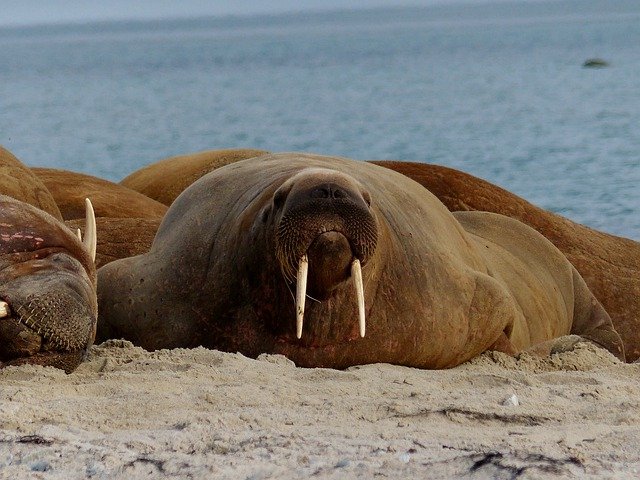
- Tusks size: 3 ft, 1 meter.
- Number of Tusks: Two.
The walrus is also known as morse, is an aquatic mammal that are unusual and freaking animals that look like seals but not so. However, they belong to a group called pinnipeds, which means ‘flipper-footed’ and have frightening tusks that grow continuously throughout their lives.
Both the male and female Walruses have relatively long tusks that are formed from the upper canine teeth making them project downward from the mouth.
Believe it or not, Walruses are social animals that can be friendly and playful, that is, You will fall in love with walruses if you are able to see Training Time with our Walrus
Narwhal (Monodon monoceros)

- Tusks size: 9 ft, 3 meters.
- Number of Tusks: One-Two.
The next animal with tusks is the unbelievable, strange and friendly whale called Narwhal, a whale found in the Arctic seas of Canada, Greenland, Norway and Russia. This whale is also fondly called “the unicorn of the ocean”.
You are stunned by the tusks of the Narwhal as they possess strange looking tusks that are sword-like in appearance with pointed ends that extend through its upper jaws.
Upon comparison, The male of the Narwhal has longer tusks than the female Narwhal. However, the female lacks the tusks, or if present it is usually small in size. However, on rare occasions, tusks can appear in females as well, and also two tusks can occur in males as well as in females. The known length of the tusk of the male Narwhal is about 8 feet.
Wild Animals With Tusks
Elephant (Loxodonta)
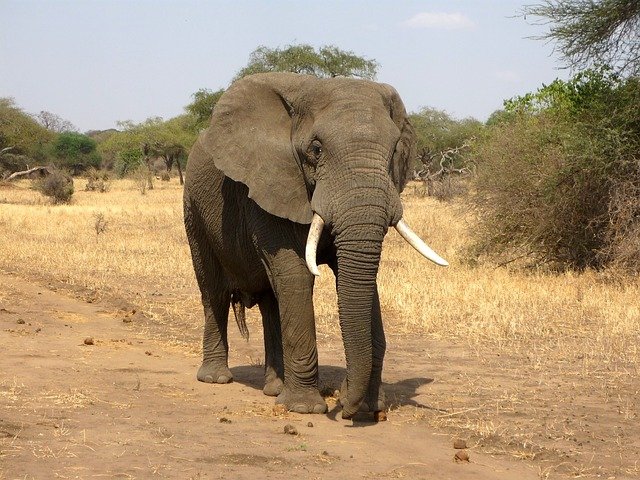
- Tusks size: 6 ft, 2 meter.
- Number of Tusks: Two.
The Elephant is the biggest land animal on earth with larger tusks than any other animal. The tusks of an elephant are actually formed by the incisor teeth that can reach about 6 feet in length.
The African bush elephant (Loxodonta africana) is named Satao is the largest elephant whose tusks are so large that they easily touch the ground.
In comparison to African female elephants the Asian female elephants have either smaller tusks or completely lack them. Contrastingly, both the males of Africa and Asian elephants have prominent tusks but African male elephants tend to have longer tusks than its Asian brother.
“Showing dominance, that is, The Bigger the Tusks Bigger the Dominance among a Herd or a Parade.”
Common Warthog (Phacochoerus africanus)

- Tusks size: 10-25 cm.
- Number of Tusks: Two large + Two small.
The Warthog is an animal with tusks which is actually a wild pig that is found in the grasslands, savanna woodlands of Africa, eastern Africa, Somalia and Ethiopia.
One animal with four tusks are these warthogs because they have one pair of tusks from the upper jaws and the other pair from the lower jaws. The tusks of the upper jaws can reach about 10-25 cm in length.
‘‘Warthogs don’t actually have warts’’
Actually, Warthogs don’t have warts in their face, instead they have wart-like bony protrusions that are intended to provide padding and protection during fights.
Chinese Water Deer (Hydropotes inermis)
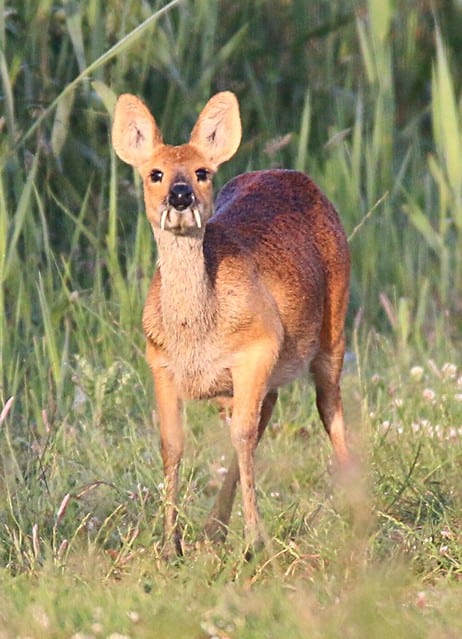
- Tusks size: 5-6 cm.
- Number of Tusks: Two.
The Deer are cute and beautiful but have you seen deer with tusks? If not, Now you are about to explore the deer with tusks called ‘Chinese water deer’ that are found in Korea, Chang Jiang, China, However, they are also introduced later to Britain.
Ironically, For defense, The Chinese water deer don’t have antlers, instead they have tusks. These tusks are long and curved which are modified from the upper canines teeth. These tusks are about 5 cm in length.
Hippopotamus (Hippopotamus amphibius)
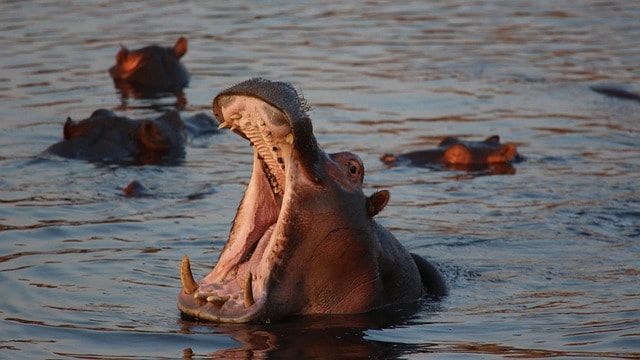
- Tusks size: 3 feet.
- Number of Tusks: Four tusks.
The next animal with tusks is the water-loving animal that can fight the crocodiles and even sometimes kill them with its long tusks is the Hippopotamus.
The Hippos are also known as Hippos and ‘water horses’ that are found in Uganda, Tanzania, Kenya, Ethiopia, Somalia, Sudan, and other countries. The tusks of these animals are large with pointed ends that are found in the upper incisors and the lower canines. They can reach about 3 feet or 1 meter in length with enamel on it.
Interestingly, The ivory of Hippos is harder than elephants, Thus it is more difficult to carve the tusks of hippos.
Wild Boar (Sus scrofa)
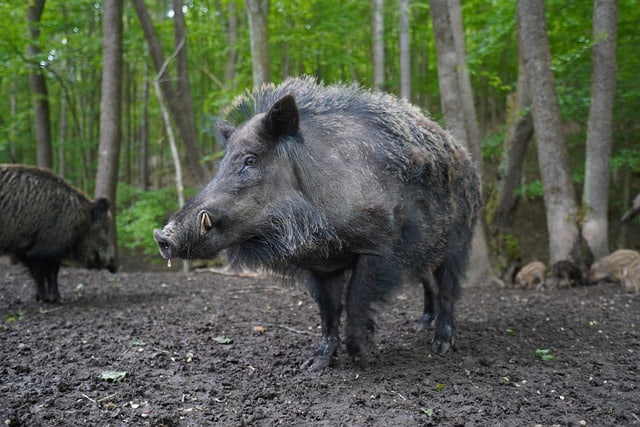
- Tusks size: 7-18 inches.
- Number of Tusks: Four.
The wild boar is also known as the wild swine, wild pig, or simply wild pig in Europe, Africa, India, Andaman Islands, China, and other countries.
Average length of the Wild boar tusk is about 7 inches, But in some boar the tusks can grow up to 18 inches.
Unlike other deers, The Wild boars are nocturnal animals meaning they rest and sleep in the day and are active throughout the night.
Babirusa (Babyrousa)
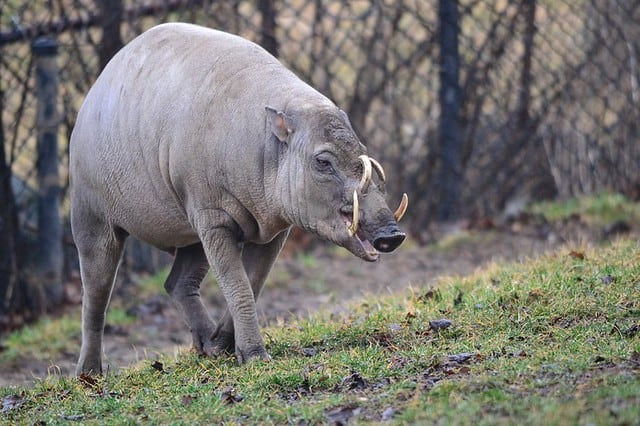
- Tusks size: 17 inches.
- Number of Tusks: Four.
Let me introduce the next animal that may freak you out as it has unusual four tusks.
The babirusas, also known as deer-pigs, are found in the Indonesian islands of Sulawesi, Togian, Sula, Bur, etc. The canine tusk of the male babirusas is so big with curves that can penetrate into its snout while growing. The tusk can reach a length of 17 inches.
For convenience, We keep calling Babirusa as deer-pigs, even though they are not related to deers. However, what makes them have that name is that they possess deer-like legs and tusks that resemble the antlers of deers.
Tufted Deer (Elaphodus cephalophus)
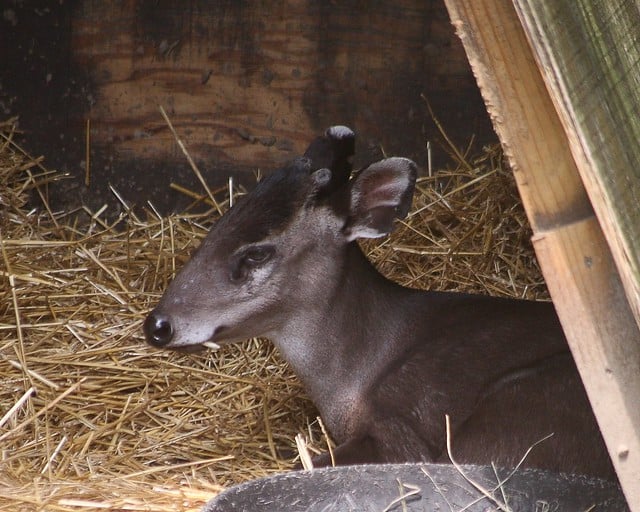
- Tusks size: 1 inch.
- Number of Tusks: Two.
The tufted deer is a small-sized deers with two tusks found in China and other Asian regions.
What frightens us in the innocent Tufted deer is their long canine teeth make them look like vampires as they are about 1 inch and can be used as defense. However, When predators chase, these deers run in an ‘S’ pattern in order to escape from them.
Musk Deer (Moschus)
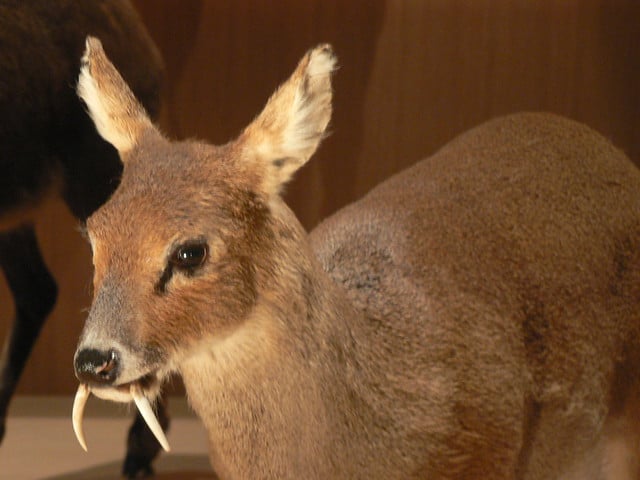
- Tusks size: 7 cm.
- Number of Tusks: Two.
There are many types of musk deers have tusks. Those types can be Siberian musk deer, Alpine musk deer, White-bellied musk deer, Black musk deer.
Actually, The male musk deer don’t have antlers for defense, instead they are equipped with a long tusk that is about 7cm in length.
Have you wondered why musk deer are called so? Because they have glands that produce a substance called Musk to attract the female deers.
Elk
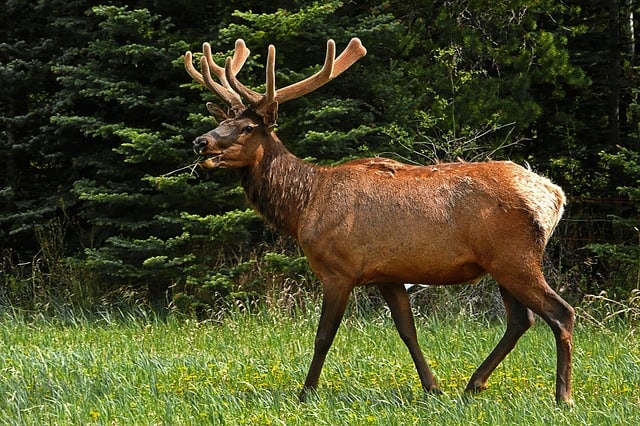
- Tusks size: 6-8 inches.
- Number of Tusks: Two.
The next animal with tusks are the Elk that belong to old world deer that are found in North America, Canada, and in zoos. The types of Elk can be Manitoban Elk, Rocky Mountain Elk, Tule Elk, Roosevelt’s Elk, and Eastern Elk.
Today’s Elk have ivory types of tusks that can grow up to 6-8 inches which is expected to be passed down to them from their ancestors who have the ivory type of tusks around thousands of years ago.
Extinct Animals with Tusks
Sabre-Toothed Cat

- Tusks size: 8 inches.
- Number of Tusks: Two.
The Sabre-toothed Cat commonly known as the Sabre-toothed tiger is an extinct animal that has scary sharp teeth protruding outside the mouth used to catch the larger prey that was present thousands of years ago. They have long teeth or tusks that are about 8 inches in length.
Since Sabre-toothed Cats belong to the carnivorous category, they are usually found to hunt big animals such as camels, horses, and other big animals that existed many years ago.
Woolly Mammoth
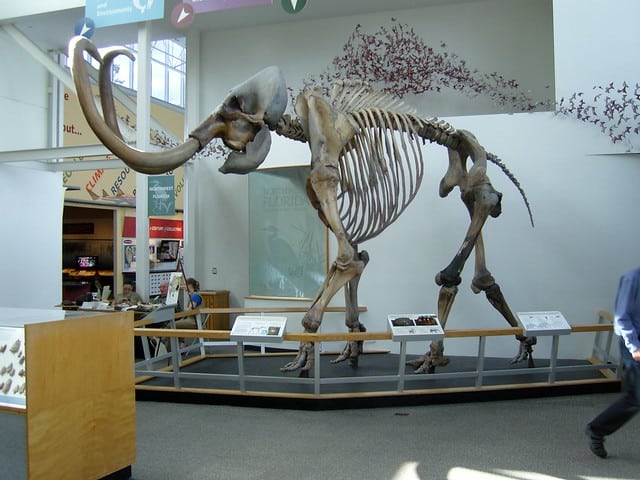
- Tusks size: 10-12 feet.
- Number of Tusks: Two.
The woolly mammoth is a species of mammoth that belongs to extinct animals that thrived successfully about thousands of years ago and was related to the current living elephants and is relatively larger than today’s elephants but with relatively smaller years to avoid heat loss.
Impressive thing about them is that they have tusks that are about 10-12 feet in length and that’s huge.
American Mastodons
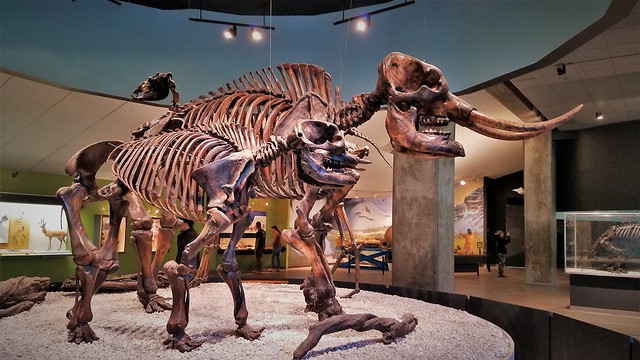
- Tusks size: 7-15 feet.
- Number of Tusks: Two.
The next extinct animal with tusks is the American mastodon that are distantly related to today’s elephants. These are larger land animals living in solitary and are found in Yukon to central Mexico, and from the Pacific to Atlantic coasts.
Surprisingly, There are four tusks present in these animals, two tusks about 7 feet in length from the upper jaws. While the remaining two tusks from lower jaws that became vestigial with passage of time. However, In a few cases, they were found to have tusks that are about 15 feet in length.
In size, The American mastodons were slightly smaller than mammoths, that is, the mastodons have shorter legs and other body parts than the mammoths.
Gomphotheres
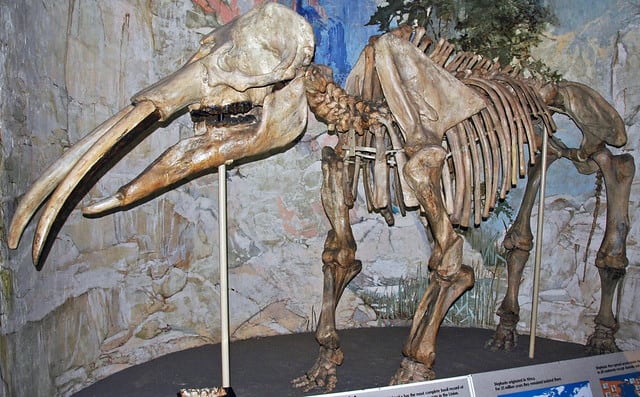
Number of Tusks: Four.
The Gomphotheres are extinct animals that were similar in appearance to the elephants but do not belong to the family Elephantidae, and lived during the Miocene and Pliocene epochs in North America and other regions.
One of the noticeable unique features about the Gomphothere is that some of them have lower tusks along with the common upper tusks thus they have four tusks.
Read More : 23 Animals With Opposable Thumbs
Sources:
https://www.worldatlas.com/articles/what-is-a-tusk-and-which-animals-have-it.html
